Lincoln K1727-4, K1727-3 User Manual
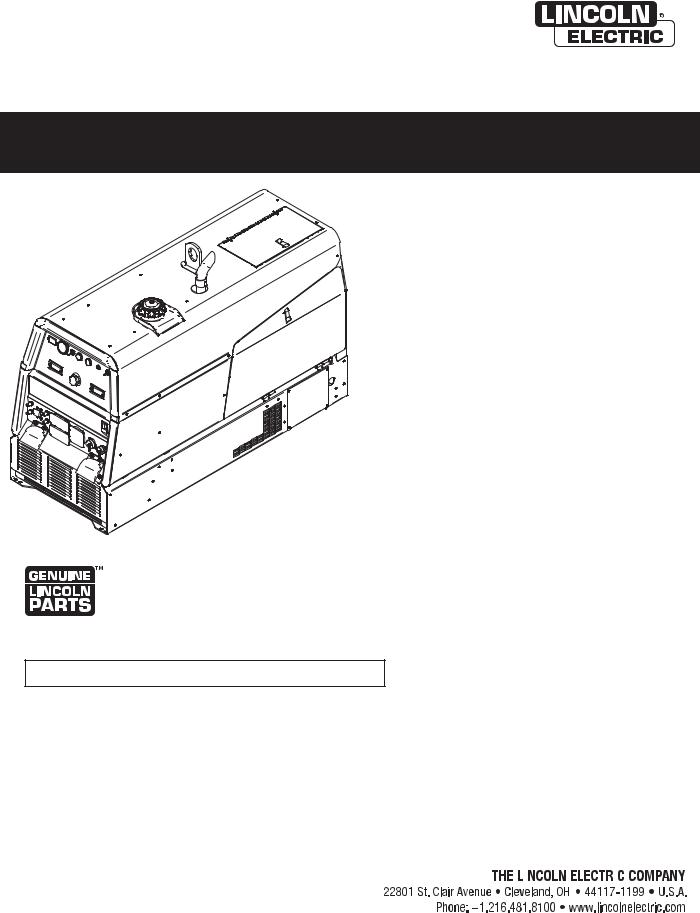
Operator’s Manual
RANGER ®305D
For use with machines having Code Numbers:
11457, 11909
Register your machine:
www.lincolnelectric.com/register
Authorized Service and Distributor Locator:
www.lincolnelectric.com/locator
Save for future reference
Date Purchased
Need Help? Call 1.888.935.3877 to talk to a Service Representative
Hours of Operation:
8:00 AM to 6:00 PM (ET) Mon. thru Fri.
After hours?
Use “Ask the Experts” at lincolnelectric.com
A Lincoln Service Representative will contact you no later than the following business day.
|
For Service outside the USA: |
|||
|
Email: globalservice@lincolnelectric.com |
|||
Code: (ex: 10859) |
||||
|
|
|
||
|
|
|
|
|
|
|
|
|
|
Serial: (ex: U1060512345) |
|
|
|
|
|
|
|
|
|
|
|
|
|
|
IM970-A | Issue Date Sept13
© Lincoln Global, Inc. All Rights Reserved.
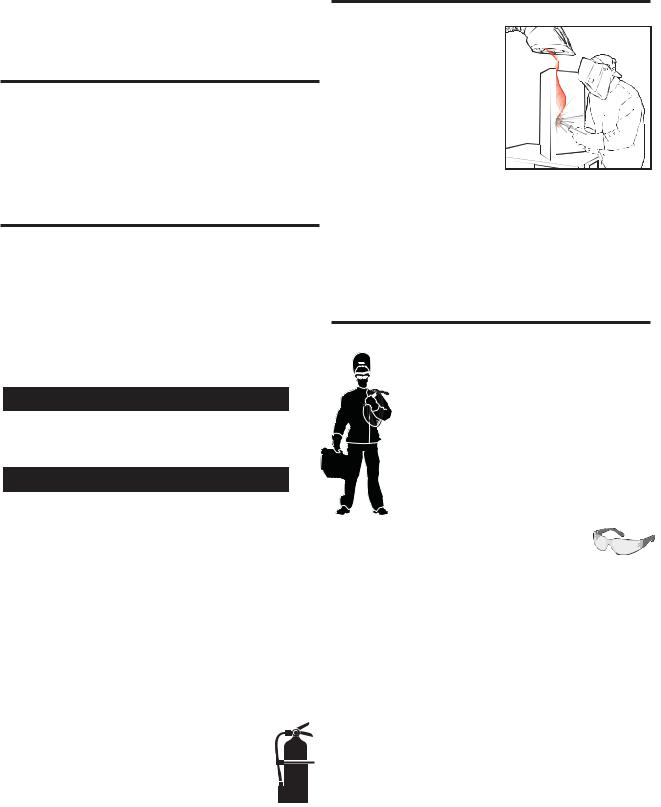
THANK YOU FOR SELECTING
A QUALITY PRODUCT BY
LINCOLN ELECTRIC.
PLEASE EXAMINE CARTON AND EQUIPMENT FOR DAMAGE IMMEDIATELY
When this equipment is shipped, title passes to the purchaser upon receipt by the carrier. Consequently, Claims for material damaged in shipment must be made by the purchaser against the transportation company at the time the shipment is received.
SAFETY DEPENDS ON YOU
Lincoln arc welding and cutting equipment is designed and built with safety in mind. However, your overall safety can be increased by proper installation ... and thoughtful operation on your part.
DO NOT INSTALL, OPERATE OR REPAIR THIS EQUIPMENT WITHOUT READING THIS MANUAL AND THE SAFETY PRECAUTIONS CONTAINED THROUGHOUT. And, most importantly, think before you act and be careful.
 WARNING
WARNING
This statement appears where the information must be followed exactly to avoid serious personal injury or loss of life.
 CAUTION
CAUTION
This statement appears where the information must be followed to avoid minor personal injury or damage to this equipment.
KEEP YOUR HEAD OUT OF THE FUMES.
DON’T get too close to the arc. Use corrective lenses if necessary to
stay a reasonable distance away from the arc.
READ and obey the Material Safety Data Sheet (MSDS) and the warning
label that appears on all containers
of welding materials.
USE ENOUGH VENTILATION or exhaust at the arc, or both, to keep
the fumes and gases from your breathing zone and the general area. IN A LARGE ROOM OR OUTDOORS, natural ventilation may be adequate if you keep your head out of the fumes (See below).
USE NATURAL DRAFTS or fans to keep the fumes away from your face.
If you develop unusual symptoms, see your supervisor. Perhaps the welding atmosphere and ventilation system should be checked.
WEAR CORRECT EYE, EAR & BODY PROTECTION
PROTECT your eyes and face with welding helmet
properly fitted and with proper grade of filter plate
(See ANSI Z49.1).
PROTECT your body from welding spatter and arc
flash with protective clothing including woolen clothing, flame-proof apron and gloves, leather
leggings, and high boots.
PROTECT others from splatter, flash, and glare with protective screens or barriers.
IN SOME AREAS, protection from noise may be appropriate.
BE SURE protective equipment is in good condition.
Also, wear safety glasses in work area AT ALL TIMES.
SPECIAL SITUATIONS
DO NOT WELD OR CUT containers or materials which previously had been in contact with hazardous substances unless they are properly cleaned. This is extremely dangerous.
DO NOT WELD OR CUT painted or plated parts unless special precautions with ventilation have been taken. They can release highly toxic fumes or gases.
Additional precautionary measures
PROTECT compressed gas cylinders from excessive heat, mechanical shocks, and arcs; fasten cylinders so they cannot fall.
BE SURE cylinders are never grounded or part of an electrical circuit. REMOVE all potential fire hazards from welding area.
ALWAYS HAVE FIRE FIGHTING EQUIPMENT READY FOR IMMEDIATE USE AND KNOW HOW TO USE IT.
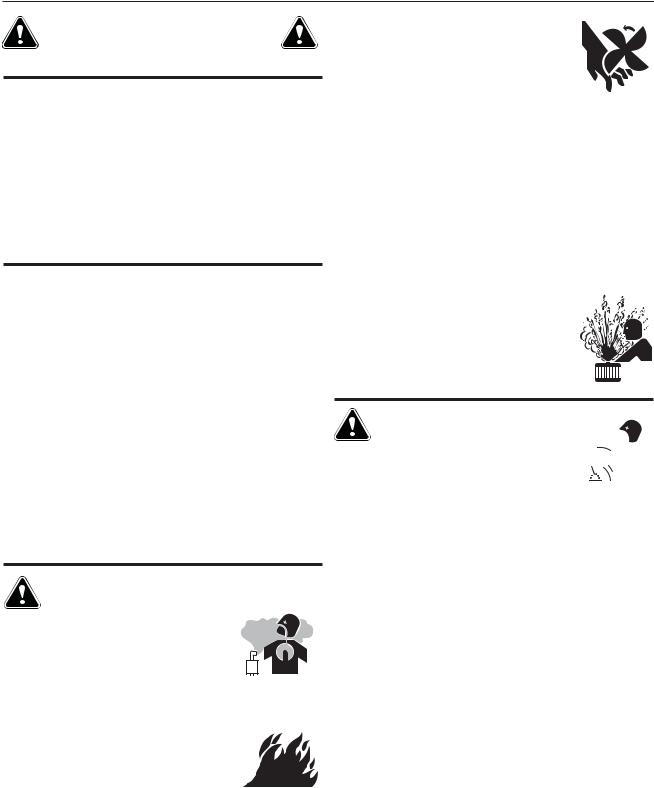
SAFETY
SECTION A:
WARNINGS
CALIFORNIA PROPOSITION 65 WARNINGS
Diesel Engines
Diesel engine exhaust and some of its constituents are known
to the State of California to cause cancer, birth defects, and other reproductive harm.
Gasoline Engines
The engine exhaust from this product contains chemicals known to the State of California to cause cancer, birth defects, or other reproductive harm.
ARC WELDING CAN BE HAZARDOUS. PROTECT YOURSELF AND OTHERS FROM POSSIBLE SERIOUS INJURY OR DEATH. KEEP CHILDREN AWAY. PACEMAKER WEARERS SHOULD CONSULT WITH THEIR DOCTOR BEFORE OPERATING.
Read and understand the following safety highlights. For additional safety information, it is strongly recommended that you purchase a copy of “Safety in Welding & Cutting - ANSI Standard Z49.1” from the American Welding Society, P.O. Box 351040, Miami, Florida 33135 or CSA Standard W117.2-1974. A Free copy of “Arc Welding Safety” booklet E205 is available from the Lincoln Electric Company, 22801 St. Clair Avenue, Cleveland, Ohio 44117-1199.
BE SURE THAT ALL INSTALLATION, OPERATION, MAINTENANCE AND REPAIR PROCEDURES ARE PERFORMED ONLY BY QUALIFIED INDIVIDUALS.
FOR ENGINE POWERED
EQUIPMENT.
1.a. Turn the engine off before troubleshooting and maintenance work unless the maintenance work requires it to be running.
1.b. Operate engines in open, well-ventilated
areas or vent the engine exhaust fumes outdoors.
1.c. Do not add the fuel near an open flame
welding arc or when the engine is running. Stop the engine and allow it to cool before
refueling to prevent spilled fuel from vaporizing on contact with hot engine parts and igniting. Do not spill fuel when filling
tank. If fuel is spilled, wipe it up and do not start engine until fumes have been eliminated.
1.d. Keep all equipment safety guards, covers and devices in position and in good repair.Keep hands, hair, clothing and tools away from V-belts, gears, fans and all other moving parts when starting, operating or repairing equipment.
1.e. In some cases it may be necessary to remove safety guards to perform required maintenance. Remove guards only when necessary and replace them when the maintenance requiring their removal is complete. Always use the greatest care when working near moving parts.
1.f. Do not put your hands near the engine fan. Do not attempt to override the governor or idler by pushing on the throttle control rods while the engine is running.
1.g. To prevent accidentally starting gasoline engines while turning the engine or welding generator during maintenance work, disconnect the spark plug wires, distributor cap or magneto wire as appropriate.
1.h. To avoid scalding, do not remove the radiator pressure cap when the engine is hot.
ELECTRIC AND
MAGNETIC FIELDS MAY  BE DANGEROUS
BE DANGEROUS 


2.a. Electric current flowing through any conductor
causes localized Electric and Magnetic Fields (EMF). Welding current creates EMF fields around welding cables and welding machines
2.b. EMF fields may interfere with some pacemakers, and welders having a pacemaker should consult their physician before welding.
2.c. Exposure to EMF fields in welding may have other health effects which are now not known.
2.d. All welders should use the following procedures in order to minimize exposure to EMF fields from the welding circuit:
2.d.1. Route the electrode and work cables together - Secure them with tape when possible.
2.d.2. Never coil the electrode lead around your body.
2.d.3. Do not place your body between the electrode and work cables. If the electrode cable is on your right side, the work cable should also be on your right side.
2.d.4. Connect the work cable to the workpiece as close as possible to the area being welded.
2.d.5. Do not work next to welding power source.
3
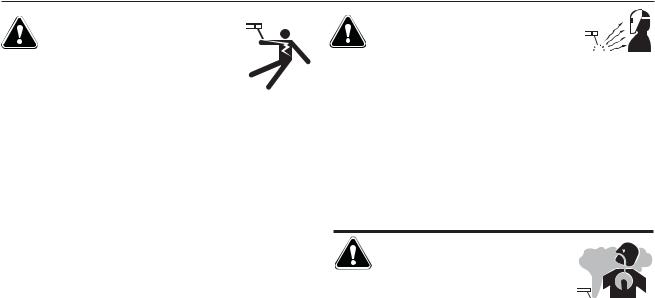
SAFETY
ELECTRIC SHOCK
CAN KILL.
3.a. The electrode and work (or ground) circuits are electrically “hot” when the welder is on. Do not touch these “hot” parts with your bare skin
or wet clothing. Wear dry, hole-free gloves to insulate hands.
3.b. Insulate yourself from work and ground using dry insulation. Make certain the insulation is large enough to cover your full area of physical contact with work and ground.
In addition to the normal safety precautions, if welding must be performed under electrically hazardous conditions (in damp locations or while wearing wet clothing; on metal structures such as floors, gratings or scaffolds; when in cramped positions such as sitting, kneeling or lying, if there is a high risk of unavoidable or accidental contact with the workpiece or ground) use the following equipment:
•Semiautomatic DC Constant Voltage (Wire) Welder.
•DC Manual (Stick) Welder.
•AC Welder with Reduced Voltage Control.
3.c. In semiautomatic or automatic wire welding, the electrode, electrode reel, welding head, nozzle or semiautomatic welding gun are also electrically “hot”.
3.d. Always be sure the work cable makes a good electrical connection with the metal being welded. The connection should be as close as possible to the area being welded.
3.e. Ground the work or metal to be welded to a good electrical (earth) ground.
3.f. Maintain the electrode holder, work clamp, welding cable and welding machine in good, safe operating condition. Replace damaged insulation.
3.g. Never dip the electrode in water for cooling.
3.h. Never simultaneously touch electrically “hot” parts of electrode holders connected to two welders because voltage between the two can be the total of the open circuit voltage of both welders.
3.i. When working above floor level, use a safety belt to protect yourself from a fall should you get a shock.
3.j. Also see Items 6.c. and 8.
ARC RAYS CAN BURN.
4.a. Use a shield with the proper filter and cover plates to protect your eyes from sparks and the rays of the arc when welding or observing open arc welding. Headshield and filter lens should conform to ANSI Z87. I standards.
4.b. Use suitable clothing made from durable flame-resistant material to protect your skin and that of your helpers from the arc rays.
4.c. Protect other nearby personnel with suitable, non-flammable screening and/or warn them not to watch the arc nor expose themselves to the arc rays or to hot spatter or metal.
FUMES AND GASES
CAN BE DANGEROUS.
5.a. Welding may produce fumes and gases hazardous to health. Avoid breathing these
fumes and gases. When welding, keep your head out of the fume. Use enough ventilation and/or exhaust at the arc to keep fumes and gases away from the breathing zone. When welding with electrodes which require special ventilation such as stainless or hard facing (see instructions on container or MSDS) or on lead or cadmium plated steel and other metals or coatings which produce highly toxic fumes, keep exposure as low as possible and within applicable OSHA PEL and ACGIH TLV limits using local exhaust or mechanical ventilation. In confined spaces or in some circumstances, outdoors, a respirator may be required. Additional precautions are also required when welding on galvanized steel.
5.b. The operation of welding fume control equipment is affected by various factors including proper use and positioning of the equipment, maintenance of the equipment and the specific welding procedure and application involved. Worker exposure level should be checked upon installation and periodically thereafter to be certain it is within applicable OSHA PEL and ACGIH TLV limits.
5.c. Do not weld in locations near chlorinated hydrocarbon vapors coming from degreasing, cleaning or spraying operations. The heat and rays of the arc can react with solvent vapors to form phosgene, a highly toxic gas, and other irritating products.
5.d. Shielding gases used for arc welding can displace air and cause injury or death. Always use enough ventilation, especially in confined areas, to insure breathing air is safe.
5.e. Read and understand the manufacturer’s instructions for this equipment and the consumables to be used, including the material safety data sheet (MSDS) and follow your employer’s safety practices. MSDS forms are available from your welding distributor or from the manufacturer.
5.f. Also see item 1.b.
4

SAFETY
WELDING AND CUTTING
SPARKS CAN CAUSE
FIRE OR EXPLOSION.
6.a. Remove fire hazards from the welding area. If this is not possible, cover them to prevent the
welding sparks from starting a fire. Remember that welding sparks and hot materials from welding can easily go through small cracks and openings to adjacent areas. Avoid welding near hydraulic lines. Have a fire extinguisher readily available.
6.b. Where compressed gases are to be used at the job site, special precautions should be used to prevent hazardous situations. Refer to “Safety in Welding and Cutting” (ANSI Standard Z49.1) and the operating information for the equipment being used.
6.c. When not welding, make certain no part of the electrode circuit is touching the work or ground. Accidental contact can cause overheating and create a fire hazard.
6.d. Do not heat, cut or weld tanks, drums or containers until the proper steps have been taken to insure that such procedures will not cause flammable or toxic vapors from substances inside. They can cause an explosion even though they have been “cleaned”. For information, purchase “Recommended Safe Practices for the Preparation for Welding and Cutting of Containers and Piping That Have Held Hazardous Substances”, AWS F4.1 from the American Welding Society (see address above).
6.e. Vent hollow castings or containers before heating, cutting or welding. They may explode.
6.f. Sparks and spatter are thrown from the welding arc. Wear oil free protective garments such as leather gloves, heavy shirt, cuffless trousers, high shoes and a cap over your hair. Wear ear plugs when welding out of position or in confined places. Always wear safety glasses with side shields when in a welding area.
6.g. Connect the work cable to the work as close to the welding area as practical. Work cables connected to the building framework or other locations away from the welding area increase the possibility of the welding current passing through lifting chains, crane cables or other alternate circuits. This can create fire hazards or overheat lifting chains or cables until they fail.
6.h. Also see item 1.c.
6.I. Read and follow NFPA 51B “ Standard for Fire Prevention During Welding, Cutting and Other Hot Work”, available from NFPA, 1 Batterymarch Park, PO box 9101, Quincy, Ma 022690-9101.
6.j. Do not use a welding power source for pipe thawing.
CYLINDER MAY EXPLODE IF
DAMAGED.
7.a. Use only compressed gas cylinders containing the correct shielding gas for the process used and properly operating regulators designed for the gas and pressure used. All hoses, fittings, etc. should be suitable for the application and maintained in good condition.
7.b. Always keep cylinders in an upright position securely chained to an undercarriage or fixed support.
7.c. Cylinders should be located:
•Away from areas where they may be struck or subjected to physical damage.
•A safe distance from arc welding or cutting operations and any other source of heat, sparks, or flame.
7.d. Never allow the electrode, electrode holder or any other electrically “hot” parts to touch a cylinder.
7.e. Keep your head and face away from the cylinder valve outlet when opening the cylinder valve.
7.f. Valve protection caps should always be in place and hand tight except when the cylinder is in use or connected for use.
7.g. Read and follow the instructions on compressed gas cylinders, associated equipment, and CGA publication P-l, “Precautions for Safe Handling of Compressed Gases in Cylinders,” available from the Compressed Gas Association 1235 Jefferson Davis Highway, Arlington, VA 22202.
FOR ELECTRICALLY
POWERED EQUIPMENT.
8.a. Turn off input power using the disconnect switch at the fuse box before working on the equipment.
8.b. Install equipment in accordance with the U.S. National Electrical Code, all local codes and the manufacturer’s recommendations.
8.c. Ground the equipment in accordance with the U.S. National Electrical Code and the manufacturer’s recommendations.
Refer to http://www.lincolnelectric.com/safety for additional safety information.
Welding Safety Interactive Web Guide for mobile devices
5
vi |
TABLE OF CONTENTS |
vi |
|
|
Page |
|
Installation....................................................................................................................... |
Section A |
|
Technical Specifications....................................................................................................... |
A-1 |
|
Safety Precautions ........................................................................................................ |
A-2 |
|
Location and Ventilation................................................................................................ |
A-2 |
|
Stacking ........................................................................................................................ |
A-2 |
|
Angle of Operation ........................................................................................................ |
A-2 |
|
Lifting............................................................................................................................. |
A-2 |
|
High Altitude Operation ................................................................................................. |
A-2 |
|
High Temperature Operation ........................................................................................ |
A-2 |
|
Cold Weather Operation ............................................................................................... |
A-2 |
|
Towing........................................................................................................................... |
A-3 |
|
Vehicle Mounting........................................................................................................... |
A-3 |
|
Pre-Operation Engine Service.............................................................................................. |
A-3 |
|
Oil.................................................................................................................................. |
A-3 |
|
Fuel ............................................................................................................................... |
A-3 |
|
Engine Coolant.............................................................................................................. |
A-4 |
|
Battery Connections...................................................................................................... |
A-4 |
|
Muffler Outlet Pipe ........................................................................................................ |
A-4 |
|
Spark Arrester ............................................................................................................... |
A-4 |
|
Remote Control ............................................................................................................. |
A-4 |
|
Electrical Connections.......................................................................................................... |
A-4 |
|
Machine Grounding....................................................................................................... |
A-4 |
|
Welding Terminals ........................................................................................................ |
A-5 |
|
Welding Output Cables ................................................................................................. |
A-5 |
|
Cable Installation........................................................................................................... |
A-5 |
|
Electrical Device Used with the Ranger 305D...................................................................... |
A-6 |
|
Auxiliary Power Receptacles and Plugs............................................................................... |
A-7 |
|
Standby Power Connections ................................................................................................ |
A-7 |
|
Premises Wiring ................................................................................................................... |
A-8 |
|
Connection of Lincoln Electric Wire Feeders............................................................... |
A-9,A-10 |
|
________________________________________________________________________________ |
|
|
Operation......................................................................................................................... |
Section B |
|
Safety Precautions .............................................................................................................. |
B-1 |
|
General Description.............................................................................................................. |
B-1 |
|
For Auxiliary Power .............................................................................................................. |
B-1 |
|
Engine Operation.................................................................................................................. |
B-1 |
|
Add Fuel ............................................................................................................................... |
B-1 |
|
Break in Period..................................................................................................................... |
B-1 |
|
Welder Controls ............................................................................................................. |
B-2,B-3 |
|
Engine Controls.................................................................................................................... |
B-3 |
|
Starting and Stopping the Engine ................................................................................. |
B-4 |
|
Welding Operation................................................................................................................ |
B-4 |
|
Duty Cycle .............................................................................................................. |
B-4,B-5 |
|
Constant Current (Stick) Welding.................................................................................. |
B-5 |
|
Downhill Pipe (Stick) Welding ....................................................................................... |
B-5 |
|
Tig Welding ................................................................................................................... |
B-5 |
|
Typical Current Ranges for Tungsten Electrodes ......................................................... |
B-5 |
|
Wire Welding-CV........................................................................................................... |
B-6 |
|
Arc Gouging .................................................................................................................. |
B-6 |
|
Auxiliary Power ............................................................................................................. |
B-7 |
|
Simultaneous Welding and Auxiliary Power Loads....................................................... |
B-7 |
|
Extension Cord Recommendations............................................................................... |
B-7 |
|
________________________________________________________________________________ |
|
|
Accessories ..................................................................................................... |
Section C |
|
Field Installed Options / Accessories ............................................................................... |
C-1 |
________________________________________________________________________________
vii |
TABLE OF CONTENTS |
vii |
|
Maintenance...................................................................................................... |
Section D |
|
Safety Precautions ................................................................................................ |
D-1 |
|
Routine Maintenance ............................................................................................ |
D-1 |
|
Engine Maintenance Components ........................................................................ |
D-1 |
|
Kubota Diesel Engine............................................................................................ |
D-1 |
|
Engine Oil Change.......................................................................................... |
D-2 |
|
Engine Oil Refill Capacities............................................................................. |
D-2 |
|
Engine Oil Filter Change................................................................................. |
D-2 |
|
Air Cleaner Service ......................................................................................... |
D-2 |
|
Service Instructions And Installation Tips for Engine Air Filter ....................... |
D-3 |
|
Cooling System ..................................................................................................... |
D-4 |
|
Fan Belt........................................................................................................... |
D-4 |
|
Fuel ................................................................................................................. |
D-4 |
|
Bleeding the Fuel System ............................................................................... |
D-4 |
|
Fuel Filter ........................................................................................................ |
D-5 |
|
Engine Adjustment .......................................................................................... |
D-5 |
|
Battery Maintenance ....................................................................................... |
D-5 |
|
Servicing Optional Spark Arrestor ................................................................... |
D-5 |
|
Welder / Generator Maintenance ........................................................................ |
D-6 |
|
Storage ........................................................................................................... |
D-6 |
|
Cleaning.......................................................................................................... |
D-6 |
|
Brush Removal and Replacement .................................................................. |
D-6 |
|
GFCI Testing and Resetting Procedure.......................................................... |
D-6 |
|
________________________________________________________________________ |
|
|
Troubleshooting .............................................................................................. |
Section E |
|
How to Use Troubleshooting Guide....................................................................... |
E-1 |
|
Troubleshooting Guide............................................................................. |
E-2 thru E-6 |
|
________________________________________________________________________ |
|
|
Diagrams and Dimension Print ...................................................................... |
Section F |
|
________________________________________________________________________ |
|
|
Parts List................................................................................................................. |
P-492 |
|
________________________________________________________________________ |
|
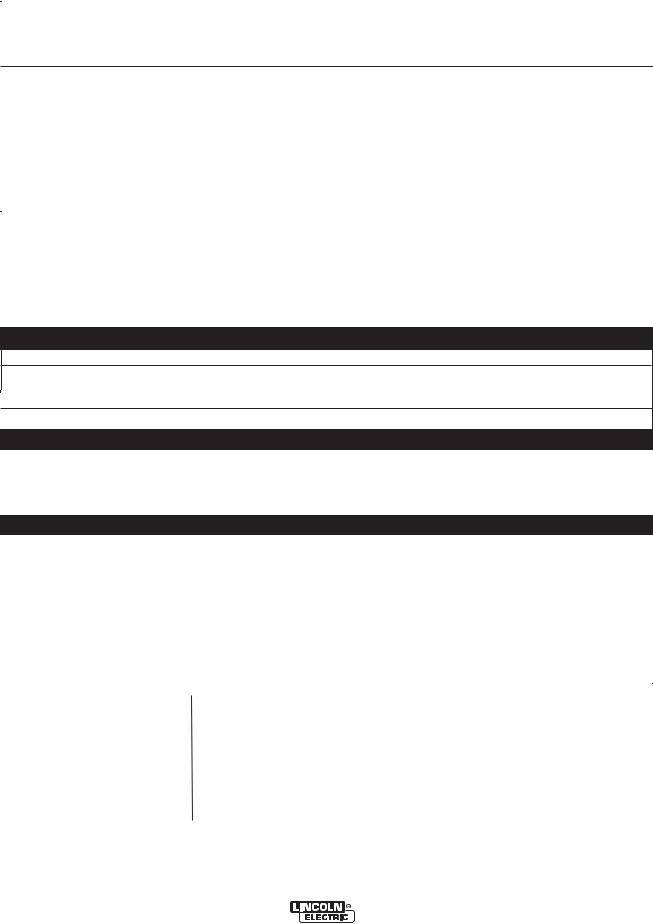
A-1 |
|
|
|
INSTALLATION |
|
|
|
A-1 |
||||
|
TECHNICAL SPECIFICATIONS - Ranger® 305D (K1727-3, K1727-4) |
|
|
|
||||||||
|
|
|
|
|
|
|
|
|
|
|
|
|
|
|
|
|
|
INPUT - DIESEL ENGINE |
|
|
|
|
|
||
|
|
|
|
|
|
|
|
|
||||
|
Make/Model |
Description |
|
Speed (RPM) |
|
Displacement |
Starting |
|
Capacities |
|
||
|
|
|
|
|
|
cu. in. (cu. cm.) |
System |
|
|
|
||
|
|
3 cylinder |
|
|
43.88(789) |
12VDC Battery & |
Fuel: 12 gal. |
|
||||
|
|
4 stroke |
|
|
|
|
starter |
|
(45 Liters) |
|
||
|
|
|
|
|
|
|
|
|||||
|
|
18.8 HP |
|
High Idle 3650 |
Bore x Stroke inch (mm) |
|
|
|
Oil: 3.4Qts. (3.2L) |
|
||
|
Kubota** |
(14 KW) |
|
|
|
|
|
|
|
|
|
|
|
D722 |
Net intermittent |
|
Full Load 3500 |
|
2.64 x 2.68 |
(Group 58; 550 |
Radiator Coolant: |
|
|||
|
|
3600 RPM |
|
|
|
(67 x 68 mm) |
cold crank amps) |
3.85Qts. (3.6L) |
|
|||
|
|
naturally aspirated |
Low Idle 2450 |
|
|
Battery Charger |
|
|
||||
|
|
water cooled |
|
|
|
|
(3.6L) |
|
|
|
||
|
|
Diesel Engine |
|
|
|
|
|
|
|
|
|
|
|
|
RATED OUTPUT @ 104° F (40° C) - WELDER |
|
|
|
|||||||
|
Welding Process |
|
Welding Output |
|
Output Range |
|
Max. Weld OCV |
|
||||
|
|
|
Current/Voltage/Duty Cycle |
|
|
|
@Rated Load RPM |
|
||||
|
DC Constant Current |
|
305A / 29V / 100% |
|
20 TO 305 AMPS |
|
|
|
|
|||
|
DC Pipe Current |
|
300A / 29V / 100% |
|
40 TO 300 AMPS |
|
|
|
|
|||
|
Touch-Start™TIG |
|
250A / 30V / 100% |
|
20 TO 250 AMPS |
|
|
60 Volts |
|
|||
|
DC Constant Voltage |
|
300A / 29V / 100% |
|
14 TO 29 VOLTS |
|
|
|
|
|||
|
|
|
|
|
|
|
|
|
|
|
|
|
RATED OUTPUT @ 104° F (40° C).- GENERATOR
Auxiliary Power 1
10,000 Watts Peak, / 9,500 Watts Continuous, 60 Hz 120/240 Volts
Sound Levels
Sound Power: 104.2 dB Lwa, Sound Level: 80.6 dBA @ 23 ft ( 7m )
PHYSICAL DIMENSIONS
HEIGHT |
WIDTH |
DEPTH |
|
WEIGHT |
|
30.00* in. |
21.50 in |
52.25 in. |
|
|
|
|
698 lbs. (317kg.) |
|
|||
762.0 mm |
546.0 mm |
1327.0 mm |
|
|
|
|
|
|
|||
|
|
|
|||
|
|
|
|
|
|
ENGINE
LUBRICATION |
|
EMISSIONS |
FUEL SYSTEM |
|
|
|
GOVERNOR |
||
Full Pressure |
Certified to EPA Tier 4 |
Mechanical Fuel Pump, Auto air bleed |
|
|
|
Mechanical |
|
||
with Full Flow Filter |
|
Compliant |
system Electric shutoff solenoid Indirect fuel injector |
|
Governor |
||||
|
|
|
|
|
|
|
|||
AIR CLEANER |
|
ENGINE IDLER |
MUFFLER |
|
ENGINE PROTECTION |
||||
|
|
|
|
Low noise Muffler: |
|
|
Shutdown on low oil |
||
Single Element |
|
Automatic Idler |
Top outlet can be rotated. |
|
|
pressure & engine |
|||
|
|
|
|
Made from long life, aluminized steel. |
|
temperature |
|||
|
|
|
|
|
|
||||
ENGINE WARRANTY: |
2 year complete (parts and labor) 3rd. year major components (parts and labor) |
||||||||
|
|
RECEPTACLES AND CIRCUIT BREAKERS |
|
|
|
||||
|
|
|
|
|
|||||
RECEPTACLES |
|
AUXILIARY POWER CIRCUIT BREAKER |
OTHER CIRCUIT BREAKERS |
||||||
|
|
|
|||||||
(2) 120VAC GFCI Duplex (5-20R) |
Two 20AMP for Two Duplex Receptacle |
15AMP for Battery Charging Circuit |
|||||||
(1) 120/240VAC Dual Voltage |
One 50AMP for Dual Voltage(2-pole) |
15AMP for 42V Wire Feeder Power |
|||||||
Full KVA (14-50R) |
|
|
|
|
|
|
|
|
|
|
|
|
|
|
|
|
|
|
|
1.Output rating in watts is equivalent to volt-amperes at unity power factor. Output voltage is within ± 10% at all loads up to rated capacity. When welding, available auxiliary power will be reduced.
*Top of enclosure add 6in. (152mm) for exhaust pipe.
**Engine warranty may vary outside of the USA. (See Engine warranty for details)
RANGER® 305D
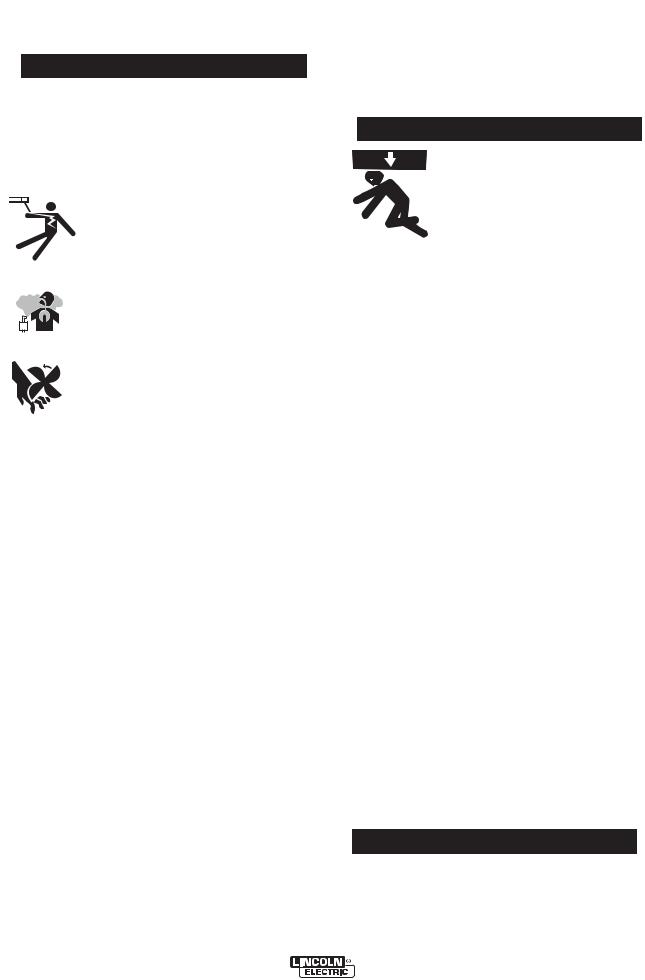
A-2 |
INSTALLATION |
A-2 |
SAFETY PRECAUTIONS
 WARNING
WARNING
Do not attempt to use this equipment until you have thoroughly read the engine manufacturerʼs manual supplied with your welder. It includes important safety precautions, detailed engine starting, operating and maintenance instructions, and parts lists.
------------------------------------------------------------------------
ELECTRIC SHOCK can kill.
•Do not touch electrically live parts or electrode with skin or wet clothing.
•Insulate yourself from work and ground
•Always wear dry insulating gloves.
------------------------------------------------------------------------
ENGINE EXHAUST can kill.
• Use in open, well ventilated areas or vent exhaust outside.
------------------------------------------------------------------------
MOVING PARTS can injure.
•Do not operate with doors open or guards off.
• Stop engine before servicing.
• Keep away from moving parts.
------------------------------------------------------------------------
See additional warning information at front of this operatorʼs manual.
Only qualified personnel should install, use, or service this equipment.
LOCATION AND VENTILATION
The welder should be located to provide an unrestricted flow of clean, cool air to the cooling air inlets and to avoid restricting the cooling air outlets. Also, locate the welder so that the engine exhaust fumes are properly vented to an outside area.
STACKING
RANGER® 305D machines cannot be stacked.
ANGLE OF OPERATION
Engines are designed to run in the level condition which is where the optimum performance is achieved. The maximum angle of continuous operation is 20 degrees in all directions, 35 degrees Intermittent (less than 10 minutes continuous) in all directions. If the engine is to be operated at an angle, provisions must be made for checking and maintaining the oil level at the normal (FULL) oil capacity in the crankcase.
When operating the welder at an angle, the effective fuel capacity will be slightly less than the specified 12 gallons (45ltrs.).
LIFTING
The RANGER® 305D weighs approximately 775lbs.(352kg.) with a full tank of fuel (698 lbs. less fuel). A lift bail is mounted to the machine and should always be used when lifting the machine.
 WARNING
WARNING
• Lift only with equipment of ade-
|
quate lifting capacity. |
|
• Be sure machine is stable when lift- |
|
ing. |
|
• Do not lift this machine using lift |
|
bail if it is equipped with a heavy |
|
accessory such as trailer or gas |
|
cylinder. |
FALLING |
• Do not lift machine if lift bail is |
EQUIPMENT can |
damaged. |
cause injury. |
• Do not operate machine while |
|
suspended from lift bail. |
--------------------------------------------------------------------------------
HIGH ALTITUDE OPERATION
At higher altitudes, output derating may be necessary. For maximum rating, derate the machine 2.5% to 3.5% for every 1000 ft. (305m). Due to new EPA and other local emissions regulations, modifications to the engine for high altitude are restricted within the United States and some other European Countries. Use above 6000 ft.(1828 m) may be limited due to poor engine performance or excessive exhaust smoke. An authorized Kubota engine field service shop should be contacted to determine if any adjustments can be made for operation in higher elevations locally.
HIGH TEMPERATURE OPERATION
At temperatures above 104°F(40°C), Welder output derating is necessary. For maximum output ratings, derate the welder output 2 volts for every 18°F(-7.8°C) above 104°F(40°C).
Cold weather starting:
With a fully charged battery and the proper weight oil, the engine should start satisfactorily even down to about 5°F (-15°C). If the engine must be frequently started at or below 23°F (-5°C), it may be desirable to install cold-starting aides. The use of No. 1D diesel fuel is recommended in place of No. 2D at temperatures below 23°F (-5°C). Allow the engine to warm up before applying a load or switching to high idle.
Note: Extreme cold weather starting may require longer glow plug operation.
 WARNING
WARNING
Under no conditions should ether or other starting fluids be used with this engine!
--------------------------------------------------------------------------------
RANGER® 305D
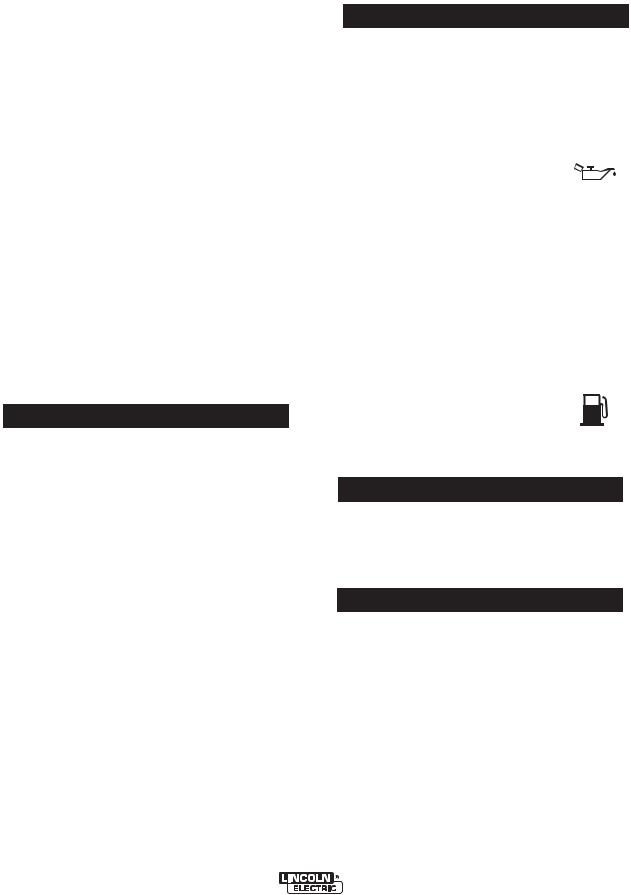
A-3 |
INSTALLATION |
A-3 |
TOWING
The recommended trailer for use with this equipment for road, in-plant and yard towing by a vehicle(1) is Lincolnʼs K957-1. If the user adapts a non-Lincoln trailer, he must assume responsibility that the method of attachment and usage does not result in a safety hazard nor damage the welding equipment. Some of the factors to be considered are as follows:
1.Design capacity of trailer vs. weight of Lincoln equipment and likely additional attachments.
2.Proper support of, and attachment to, the base of the welding equipment so there will be no undue stress to the framework.
3.Proper placement of the equipment on the trailer to insure stability side to side and front to back when being moved and when standing by itself while being operated or serviced.
4.Typical conditions of use, i.e., travel speed; roughness of surface on which the trailer will be operated; environmental conditions; like maintenance.
5.Conformance with federal, state and local laws.(1)
(1)Consult applicable federal, state and local laws regarding specific requirements for use on public highways.
VEHICLE MOUNTING
 WARNING
WARNING
Improperly mounted concentrated loads may cause unstable vehicle handling and tires or other components to fail.
•Only transport this Equipment on serviceable vehicles which are rated and designed for such loads.
•Distribute, balance and secure loads so vehicle is stable under conditions of use.
•Do not exceed maximum rated loads for components such as suspension, axles and tires.
•Mount equipment base to metal bed or frame of vehicle.
•Follow vehicle manufacturerʼs instructions.
--------------------------------------------------------------------------------
PRE-OPERATION ENGINE SERVICE
READ the engine operating and maintenance instructions supplied with this machine.
 WARNING
WARNING
•Stop engine and allow to cool before fueling
•Do not smoke when fueling.
•Fill fuel tank at a moderate rate and do not overfill.
•Wipe up spilled fuel and allow fumes to clear before starting engine.
•Keep sparks and flame away from tank.
--------------------------------------------------------------------------------
OIL
The RANGER® 305D is shipped with the engine crankcase filled with high quality SAE 10W-30 Oil that meets classification CG-4 or CH-4 for diesel engines. Check the oil level before starting the engine. If it is not up to the full mark on the dip stick, add oil as required. Check the oil level every four hours of running time during the first 50 running hours. Refer to the engine Operatorʼs Manual for specific oil recommendations and break-in information. The oil change interval is dependent on the quality of the oil and the operating environment. Refer to the Engine Operatorʼs Manual for more details on the proper service and maintenance intervals.
FUEL
DIESEL FUEL ONLY-Low sulphur fuel or ultra low sulphur fuel in U.S.A. and Canada.
 WARNING
WARNING
•Fill the fuel tank with clean, fresh fuel. The capacity of the tank is 12 gals. (45.4ltrs). When the fuel gauge reads empty the tank contains approximately 2 gals. (7.6ltrs.) of reserve fuel.
 WARNING
WARNING
NOTE: A fuel shut off valve is located on the prefilter/sediment filter. Which should be in the closed position when the welder is not ran for extended periods of time.
--------------------------------------------------------------------------------
RANGER® 305D
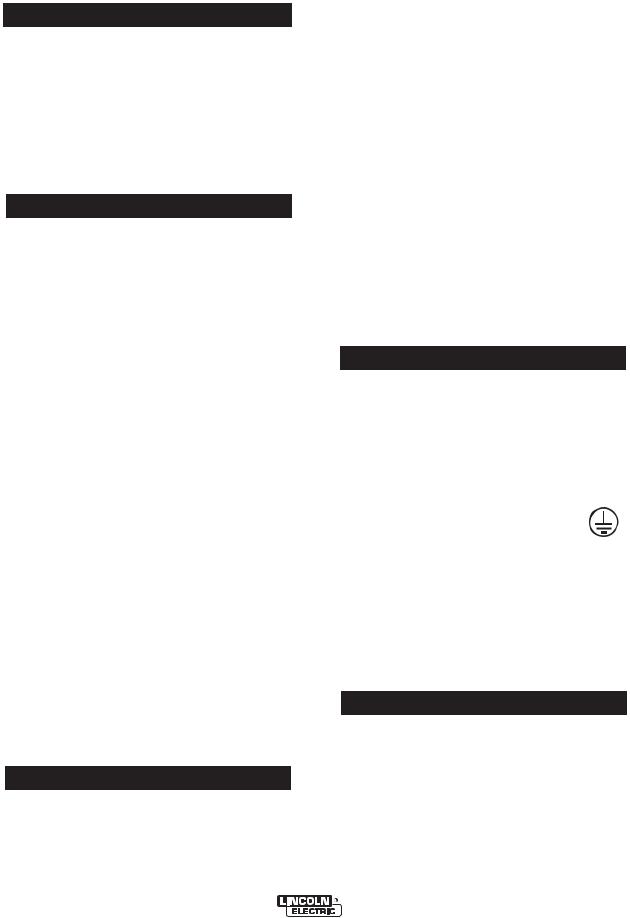
A-4 |
INSTALLATION |
A-4 |
ENGINE COOLING SYSTEM
 WARNING
WARNING
Air to cool the engine is drawn in the base sides and exhaust through radiator & case back. It is important that the intake and exhaust air is not restricted. Allow a minimum clearance of 2 feet (0.6m) from the case back and 16in.(406mm) from either side of the base to a vertical surface.
--------------------------------------------------------------------------------
BATTERY CONNECTION
 CAUTION
CAUTION
Use caution as the electrolyte is a strong acid that can burn skin and damage eyes.
--------------------------------------------------------------------------------
The RANGER® 305D is shipped with the negative battery cable disconnected. Make certain that the RUN-STOP switch is in the STOP position. Remove the two screws from the rear battery tray using a screwdriver or a 3/8" socket. Attach the negative battery cable to the negative battery terminal and tighten using a 1/2" socket or wrench.
NOTE: This machine is furnished with a wet charged battery; if unused for several months, the battery may require a booster charge. Be careful to charge the battery with the correct polarity.
MUFFLER OUTLET PIPE
Using the clamp provided secure the outlet pipe to the outlet tube with the pipe positioned such that it will direct the exhaust in the desired direction. Tighten using a 9/16" socket or wrench.
SPARK ARRESTER
Some federal, state or local laws may require that gasoline or diesel engines be equipped with exhaust spark arresters when they are operated in certain locations where unarrested sparks may present a fire hazard. The standard muffler included with this welder does not qualify as a spark arrester. When required by local regulations, a suitable spark arrester, such as the K1898-1 must be installed and properly maintained.
 WARNING
WARNING
An incorrect spark arrestor may lead to damage to the engine or adversely affect performance.
--------------------------------------------------------------------------------
REMOTE CONTROL
The RANGER® 305D is equipped with a 6-pin and a 14-pin connector. The 6-pin connector is for connecting the K857 or K857-1 Remote Control or for TIG welding, the K870 foot Amptrol or the K936-3 hand Amptrol. When in the CC-STICK, DOWNHILL PIPE, or CV-WIRE modes and when a remote control is connected to the 6-pin Connector, the auto-sensing circuit automatically switches the OUTPUT control from control at the welder to remote control.
When in TOUCH START TIG mode and when a Amptrol is connected to the 6-Pin Connector, the OUTPUT dial is used to set the maximum current range of the CURRENT CONTROL of the Amptrol.
The 14-pin connector is used to directly connect a wire feeder control cable. In the CV-WIRE mode, when the control cable is connected to the 14-pin connector, the auto-sensing circuit automatically makes the Output Control inactive and the wire feeder voltage control active
 WARNING
WARNING
NOTE: When a wire feeder with a built in welding voltage control is connected to the 14-pin connector, do not connect anything to the 6-pin connector.
--------------------------------------------------------------------------------
ELECTRICAL CONNECTIONS
MACHINE GROUNDING
Because this portable engine driven welder creates its own power, it is not necessary to connect its frame to an earth ground, unless the machine is connected to premises wiring (home, shop, etc.)
To prevent dangerous electric shock, other equipment to which this engine driven welder supplies power must:
 WARNING
WARNING
•Be grounded to the frame of the welder using a grounded type plug.
•Be double insulated.
•Do not ground the machine to a pipe that carries
explosive or combustible material.
--------------------------------------------------------------------------------
RANGER® 305D

A-5 |
INSTALLATION |
A-5 |
When this welder is mounted on a truck or trailer, its frame must be electrically bonded to the metal frame of the vehicle. Use a #8 or larger copper wire connected between the machine grounding stud and the frame of the vehicle. When this engine driven welder is connected to premises wiring such as that in a home or shop, its frame must be connected to the system earth ground. See further connection instructions in the section entitled "Standby Power Connections" as well as the article on grounding in the latest National Electrical Code and the local code.
In general, if the machine is to be grounded, it should be connected with a #8 or larger copper wire to a solid earth ground such as a metal water pipe going into the ground for at least ten feet and having no insulated joints, or to the metal framework of a building which has been effectively grounded.
The National Electrical Code lists a number of alternate means of grounding electrical equipment. A machine grounding stud marked with the symbol
is provided on the front of the welder.
WELDING TERMINALS
The RANGER® 305D is equipped with a toggle switch for selecting "hot" welding terminal when in the "WELD TERMINALS ON" position or "cold" welding terminal when in the "REMOTELY CONTROLLED" position.
WELDING OUTPUT CABLES
With the engine off connect the electrode and work cables to the output studs. The welding process dictates the polarity of the electrode cable. These connections should be checked periodically and tightened with a 3/4" wrench.
Table A.1 lists recommended cable sizes and lengths for rated current and duty cycle. Length refers to the distance from the welder to the work and back to the welder. Cable diameters are increased for long cable lengths to reduce voltage drops.
TABLE A.1
TOTAL COMBINED LENGTH OF ELECTRODE AND WORK CABLES
|
|
|
|
|
|
|
|
|
Cable Length |
|
|
Cable Size for |
|
|
|
|
|
305 Amps |
|
|
|
|
|
|
|
100% Duty Cycle |
|
|
|
0-100Ft. (0-30 meters) |
|
|
1 / 0 AWG |
|
|
|
100-150 Ft. (30-46 meters) |
|
|
2 / 0 AWG |
|
|
|
150-200 Ft. (46-61 meters) |
|
|
3 / 0 AWG |
|
|
|
|
|
|
|
|
|
|
|
|
|
|
|
CABLE INSTALLATION
Install the welding cables to your RANGER® 305D as follows.
1.The engine must be OFF to install welding cables.
2.Remove the flanged nuts from the output terminals
.
3.Connect the electrode holder and work cables to the weld output terminals. The terminals are identified on the case front.
4.Tighten the flanged nuts securely.
5.Be certain that the metal piece you are welding (the “work”) is properly connected to the work clamp and cable.
 CAUTION
CAUTION
6. Check and tighten the connections periodically.
•Loose connections will cause the output terminals to overheat. The terminals may eventually melt.
•Do not cross the welding cables at the output terminal connection. Keep the cables isolated and
separate from one another.
--------------------------------------------------------------------------------
RANGER® 305D

|
|
A-6 |
|
|
INSTALLATION |
A-6 |
|
|
|
|
|
|
|
|
|
|
|
|
|
|
|
|
TABLE lll |
|
|
|
|
|
|
|
ELECTRICAL DEVICE USE WITH THE RANGER® 305D |
|
|
||
|
|
|
|
|
|
|
|
|
|
|
Type |
|
Common Electrical Devices |
Possible Concerns |
|
|
|
|
|
|
|
|
|
|
|
|
|
|
Resistive |
|
Heaters, toasters, incandescent |
NONE |
|
|
|
|
|
|
|
|
light bulbs, electric range, hot |
|
|
|
|
|
|
|
|
pan, skillet, coffee maker. |
|
|
|
|
|
|
|
|
|
|
|
|
|
|
Capacitive |
|
TV sets, radios, microwaves, |
Voltage spikes or high voltage |
|
|
|
|
|
|
|
|
appliances with electrical control. |
regulation can cause the capaci- |
|
|
|
|
|
|
|
|
tative elements to fail. Surge |
|
|
|
|
|
|
|
|
protection, transient protection, |
|
|
|
|
|
|
|
|
and additional loading is recom- |
|
|
|
|
|
|
|
|
mended for 100% fail-safe oper- |
|
|
|
|
|
|
|
|
ation. DO NOT RUN THESE |
|
|
|
|
|
|
|
|
DEVICES WITHOUT ADDI- |
|
|
|
|
|
|
|
|
TIONAL RESISTIVE TYPE |
|
|
|
|
|
|
|
|
LOADS. |
|
|
|
|
|
|
|
|
|
|
|
|
|
Inductive |
|
Single-phase induction motors, |
These devices require large |
|
|
|
|
|
|
|
|
drills, well pumps, grinders, small |
current inrush for starting. |
|
|
|
|
|
|
|
refrigerators, weed and hedge |
Some synchronous motors may |
|
|
|
|
|
|
|
trimmers |
be frequency sensitive to attain |
|
|
|
|
|
|
|
|
maximum output torque, but |
|
|
|
|
|
|
|
|
they SHOULD BE SAFE from |
|
|
|
|
|
|
|
|
any frequency induced failures. |
|
|
|
|
|
|
|
|
|
|
|
|
|
Capacitive/Inductive |
|
Computers, high resolution TV sets, |
An inductive type line condition- |
|
|
|
|
|
|
|
|
complicated electrical equipment. |
er along with transient and |
|
|
|
|
|
|
|
|
surge protection is required, and |
|
|
|
|
|
|
|
|
liabilities still exist. DO NOT |
|
|
|
|
|
|
|
|
USE THESE DEVICES WITH A |
|
|
|
|
|
|
|
|
RANGER® 305D |
|
|
|
|
|
|
|
|
|
|
|
The Lincoln Electric Company is not responsible for any damage to electrical components improperly connected to the RANGER® 305D.
RANGER 305D

A-7 |
INSTALLATION |
A-7 |
AUXILIARY POWER RECEPTACLES
Start the engine and set the “IDLER” control switch to the “High Idle” mode. Voltage is now correct at the receptacles for auxiliary power. This must be done before a tripped GFCI receptacle can be reset properly. See the MAINTENANCE section for detailed information on testing and resetting the GFCI receptacle.
The auxiliary power of the RANGER® 305D consists of two 20 Amp-120 VAC (5-20R) duplex receptacles with GFCI protection and one 50 Amp 120/240 VAC (14-50R) receptacle. The 240 VAC receptacle can be split for single phase 120 VAC operation.
The auxiliary power capacity is 10,000 watts Peak, 9,500 Watts Continuous of 60 Hz, single phase power. The auxiliary power capacity rating in watts is equivalent to volt-amperes at unity power factor. The max permissible current of the 240 VAC output is 40 amps. The 240 VAC output can be split to provide two separate 120 VAC outputs with a max permissible current of 40 Amps per output to two separate 120 VAC branch circuits (these circuits cannot be paralleled). Output voltage is within ± 10% at all loads up to rated capacity. All auxiliary power is protected by circuit breakers.
The 120 V auxiliary power receptacles should only be used with three wire grounded type plugs or approved double insulated tools with two wire plugs. The current rating of any plug used with the system must be at least equal to the current capacity of the associated receptacle.
NOTE: The 240 V receptacle has two 120 V circuits, but are of opposite polarities and cannot be paralleled.
STANDBY POWER CONNECTIONS
The RANGER® 305D is suitable for temporary, standby or emergency power using the engine manufacturerʼs recommended maintenance schedule.
The RANGER® 305D can be permanently installed as a standby power unit for 240 VAC, 3 wire, single phase, 40 amp service. Connections must be made by a licensed electrician who can determine how the 120/240 VAC power can be adapted to the particular installation and comply with all applicable electrical codes.
•Install the double-pole, double-throw switch between the power company meter and the premises disconnect. Switch rating must be the same or greater than the customerʼs premises disconnect and service over current protection.
•Take necessary steps to assure load is limited to the capacity of the RANGER® 305D by installing a 50 amp, 240 VAC double pole circuit breaker. Maximum rated load for each leg of the 240 VAC auxiliary is 40 amperes. Loading above the rated output will reduce output voltage below the allowable - 10% of rated voltage which may damage appliances or other motor-driven equipment and may result in overheating of the RANGER® 305D engine and/or alternator windings.
•Install a 50 amp, 120/240 VAC plug (NEMA Type 14-50) to the double-pole circuit breaker using No. 6, 4 conductor cable of the desired length. (The 50 amp, 120/240 VAC plug is available in the optional K802R plug kit or as part number T12153-9.)
•Plug this cable into the 50 Amp, 120/240 Volt receptacle on the RANGER® 305D case front.
RANGER® 305D
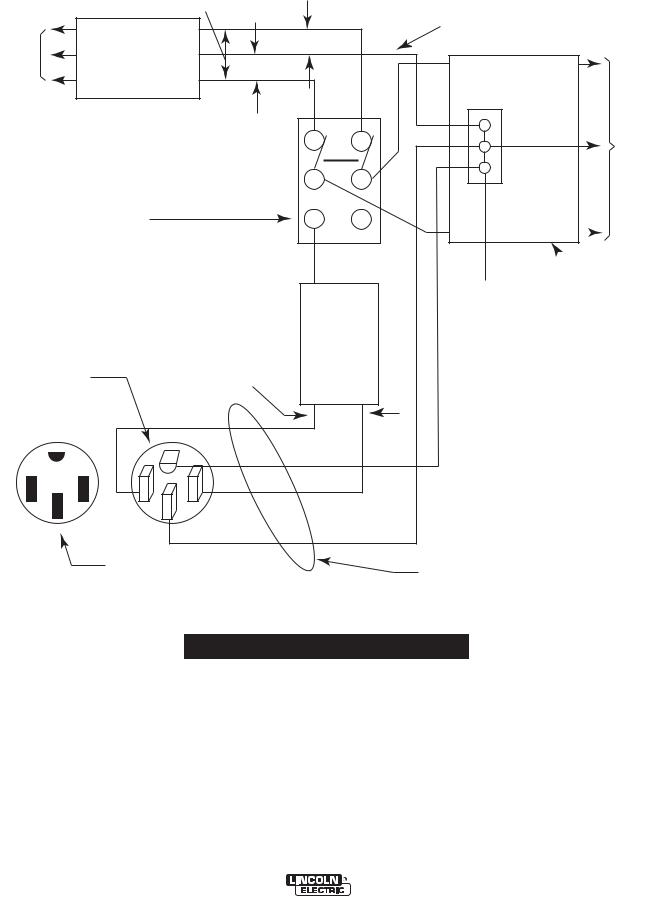
A-8 |
INSTALLATION |
A-8 |
CONNECTION OF RANGER® 305D TO PREMISES WIRING
|
|
240 VOLT |
|
|
POWER |
GROUNDED CONDUCTOR |
|
240 Volt |
120 VOLT |
||
|
|||
60 Hz. |
|
||
COMPANY |
|
||
3-Wire |
120 VOLT |
||
|
|||
Service |
|||
METER |
|
||
|
|
||
|
|
NEUTRAL |
|
|
|
BUS |
N
LOAD
DOUBLE POLE DOUBLE THROW
SWITCH RATING TO BE THE SAME
AS OR GREATER THAN PREMISES
SERVICE OVERCURRENT
PROTECTION.
|
|
|
|
|
|
|
|
|
|
|
|
|
|
|
|
|
|
|
|
PREMISES |
|||
|
|
|
|
|
|
|
|
DISCONNECT AND |
|||
|
|
|
|
|
|
|
|
SERVICE |
|||
|
GROUND |
||||||||||
50AMP |
OVERCURRENT |
||||||||||
|
|
|
|
|
|
|
|||||
|
|
|
|
|
|
|
PROTECTION |
||||
240 VOLT |
|
|
|
|
|
|
|
||||
|
|
|
|
|
|
|
|
|
|
||
|
|
DOUBLE |
|
50 AMP, 120/240 |
|
POLE |
|
|
CIRCUIT |
||
VOLT PLUG |
240 VOLT |
||
BREAKER |
|||
NEMA TYPE 14-50 |
|
|
GND
N
50 AMP, 120/240 VOLT
RECEPTACLE NOTE: No. 6 COPPER CONDUCTOR CABLE SEE NATIONAL ELECTRICAL CODE FOR ALTERNATE WIRE
SIZE RECOMMENDATIONS.
 WARNING
WARNING
•Only a licensed, certified, trained electrician should install the machine to a premises or residential electrical system. Be certain that:
•The installation complies with the National Electrical Code and all other applicable electrical codes.
•The premises is isolated and no feedback into the utility system can occur. Certain state and local laws require the premises to be isolated before the generator is linked to the premises. Check your state and local requirements.
•A double pole, double throw transfer switch in conjunction with the properly rated double throw circuit breaker is connected between the generator power and the utility meter.
RANGER® 305D

A-9 |
INSTALLATION |
A-9 |
CONNECTION OF LINCOLN ELECTRIC WIRE FEEDERS
Connection of LN-7 or LN-8 to the RANGER® 305D
•Shut the welder off.
•Connect the LN-7 or LN-8 per instructions on the appropriate connection diagram in Section F.
•Set the "WIRE FEEDER VOLTMETER" switch to either "+" or "-" as required by the electrode being used.
•Set the "MODE" switch to the "CV WIRE " position.
•Set the "ARC CONTROL" knob to "0" initially and adjust to suit.
•Set the "WELD TERMINALS" switch to the "REMOTELY CONTROLLED" position.
•Set the "IDLE" switch to the "HIGH" position.
Connection of LN-15 to the Ranger® 305D
These connections instructions apply to both the LN15 Across The-Arc and Control Cable models. The LN-15 has an internal contactor and the electrode is not energized until the gun trigger is closed. When the gun trigger is closed the wire will begin to feed and the welding process is started.
•Shut the welder off.
•For electrode Positive, connect the electrode cable to the "+" terminal of the welder and work cable to the "-" terminal of the welder. For electrode Negative, connect the electrode cable "-" terminal of the welder and work cable to the "+" terminal of the welder.
•Across The-Arc Model:
Attach the single lead from the front of the LN-15 to work using the spring clip at the end of the lead. This is a control lead to supply current to the wire feeder motor; it does not carry welding current.
Set the "WELD TERMINALS" switch to "WELD TERMINALS ON"
•Control Cable Model:
Connect Control Cable between Engine Welder and Feeder.
Set the "WELD TERMINALS" switch to "REMOTELY CONTROLLED".
•Set the MODE switch to the "CV-WIRE " position.
•Set the "WIRE FEEDER VOLTMETER" switch to either "+" or "-" as required by the electrode polarity being used.
•Set the "ARC CONTROL" knob to "0" initially and adjust to suit.
•Set the "IDLE" switch to the "AUTO" position
RANGER® 305D

A-10 |
INSTALLATION |
A-10 |
 WARNING
WARNING
Connection of the LN-25 to the RANGER® 305D Shut off welder before making any electrical connections.
--------------------------------------------------------------------------------
The LN-25 with or without an internal contactor may be used with the RANGER® 305D. See the appropriate connection diagram in Section F.
1.Shut the welder off.
2.For electrode Positive, connect the electrode cable from the LN-25 to the "+" terminal of the welder and work cable to the "-" terminal of the welder. For electrode Negative, connect the electrode cable from the LN-25 to the "-" terminal of the welder and work cable to the "+" terminal of the welder.
3.Attach the single lead from the front of the LN-25 to work using the spring clip at the end of the lead. This is a control lead to supply current to the wire feeder motor; it does not carry welding current.
4.Set the MODE switch to the "CV-WIRE " position.
5.Set the "WELD TERMINALS" switch to "WELD TERMINALS ON"
6.Set the "ARC CONTROL" knob to "0" initially and adjust to suit.
7.Set the "IDLE" switch to the "AUTO" position. When not welding, the RANGER® 305D engine will be at the low idle speed. If you are using an LN-25 with an internal contactor, the electrode is not energized until the gun trigger is closed.
8.When the gun trigger is closed, the current sensing circuit will cause the RANGER® 305D engine to go to the high idle speed, the wire will begin to feed and the welding process started. When welding is stopped, the engine will revert to low idle speed after approximately 12 seconds unless welding is resumed.
 CAUTION
CAUTION
If you are using an LN-25 without an internal contactor, the electrode will be energized when the Ranger® 305D is started.
--------------------------------------------------------------------------------
Connection of LN-742, Spool Gun (K487-25) and Cobramatic to RANGER® 305D
•Shut the welder off.
•Connect per instructions on the appropriate connection diagram in Section F.
Connection of PRINCE XL SPOOL GUN to the Ranger® 305D
Connection of the Prince XL Spool Gun requires the use of the K1849-1 Adapter Module.
•Shut the Welder off.
•For electrode Positive, connect the electrode cable to the "+" terminal of the welder and work cable to the "-" terminal of the welder. For electrode Negative, connect the electrode cable "-" terminal of the welder and work cable to the "+" terminal of the welder.
•Connect the Control Cable of the Spool Gun to the Adapter Module and connect the Control Cable of the Adapter Module to the Welder.
•Connect the Gas Hose.
•Set the MODE switch to the "CV-WIRE " position.
•Set the "WELD TERMINALS" switch to "WELD TERMINALS ON".
•Set the "ARC CONTROL" knob to "0" initially and adjust to suit.
•Set the “IDLE” switch to the “HIGH” position.
RANGER® 305D
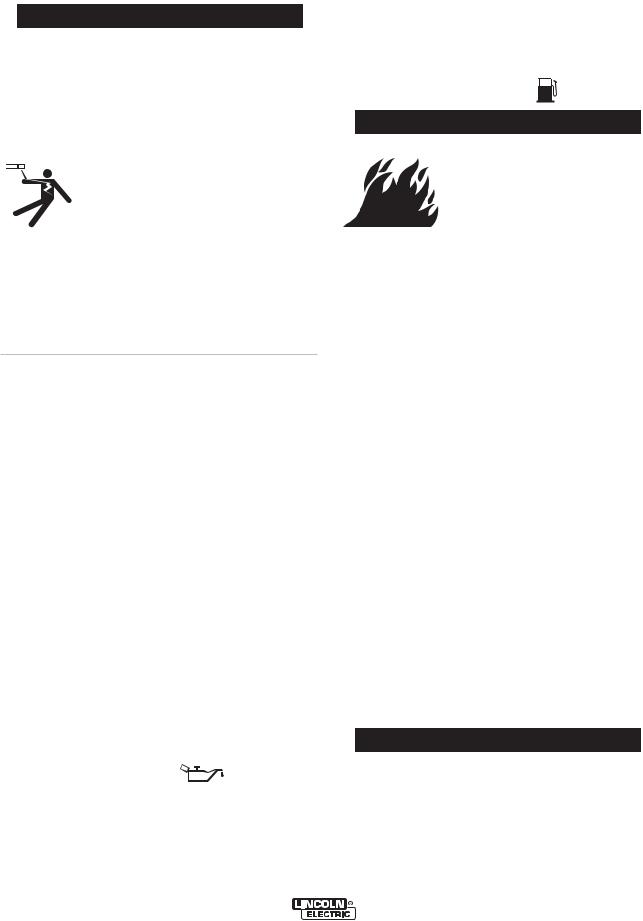
B-1 |
OPERATION |
B-1 |
SAFETY PRECAUTIONS
 WARNING
WARNING
Do not attempt to use this equipment until you have thoroughly read the engine manufacturerʼs manual supplied with your welder. It includes important safety precautions, detailed engine starting, operating and maintenance instructions, and parts lists.
------------------------------------------------------------------------
ELECTRIC SHOCK can kill.
•Do not touch electrically live parts or electrode with skin or wet clothing.
•Insulate yourself from work and ground
•Always wear dry insulating gloves.
•Always operate the welder with the hinged door closed and the side panels in place.
•Read carefully the Safety Precautions page before operating this machine. Always follow these and any other safety procedures included in this manual and in the Engine Instruction Manual.
GENERAL DESCRIPTION
The RANGER® 305D is a diesel engine powered DC multi-process welding power source and 120 / 240 volt AC power generator. The engine drives a generator that supplies three phase power for the DC welding circuit and single phase power for the AC auxiliary outlets. The DC welding control system uses state of the art Chopper Technology (CT tm) for superior welding performance.
FOR AUXILIARY POWER:
Start the engine and set the IDLER control switch to the desired operating mode. Full power is available regardless of the welding control settings providing no welding current is being drawn.
The auxiliary power of the RANGER® 305D consists of two 20 Amp-120 VAC (5-20R) duplex receptacles with GFCI protection and one 50 Amp 120/240 VAC (14-50R) receptacle. The 240 VAC receptacle can be split for single phase 120 VAC operation. Also refer to the AUXILIARY POWER OPERATION section later in this chapter.
ENGINE OPERATION
Before Starting the Engine:
•Be sure the machine is on a level surface.
•Open top & side engine doors and remove the engine oil dipstick and wipe it with a clean cloth. Reinsert the dipstick and check the level on the dipstick.
•Add oil (if necessary) to bring the level up to the full mark. Do not overfill. Close engine door.
•Check radiator for proper coolant level. (Fill if necessary).
•See Engine Ownerʼs Manual for specific oil and coolant recommendations.
ADD FUEL
 WARNING
WARNING
•Stop engine while fueling.
•Do not smoke when fueling.
•Keep sparks and flame away from tank.
•Do not leave unattended while fueling.
DIESEL FUEL • Wipe up spilled fuel and allow fumes to clear before starting
engine.
• Do not overfill tank, fuel expan-
sion may cause overflow.
DIESEL FUEL ONLY-Low sulphur fuel or ultra low sulphur fuel in U.S.A. and Canada.
--------------------------------------------------------------------------------
•Remove the fuel tank cap.
•Fill the tank approximately 4 inches (100mm) from the top of the filler neck to allow for fuel expansion . DO NOT FILL THE TANK TO THE POINT OF OVERFLOW.
•Replace the fuel cap and tighten securely.
•See Engine Ownerʼs Manual for specific fuel recommendations.
BREAK-IN PERIOD
Any engine will use a small amount of oil during its “break-in” period. For the diesel engine on the RANGER® 305D, break-in is about 50 running hours.
Check the oil every four hours during break-in. Change the oil after the first 50 hours of operation,every 100 hours thereafter. Change the oil filter at the second oil change.
 CAUTION
CAUTION
During break-in, subject the RANGER® 305D to moderate loads. Avoid long periods running at idle. Before stopping the engine, remove all loads and allow the engine to cool several minutes.
--------------------------------------------------------------------------------
RANGER® 305D
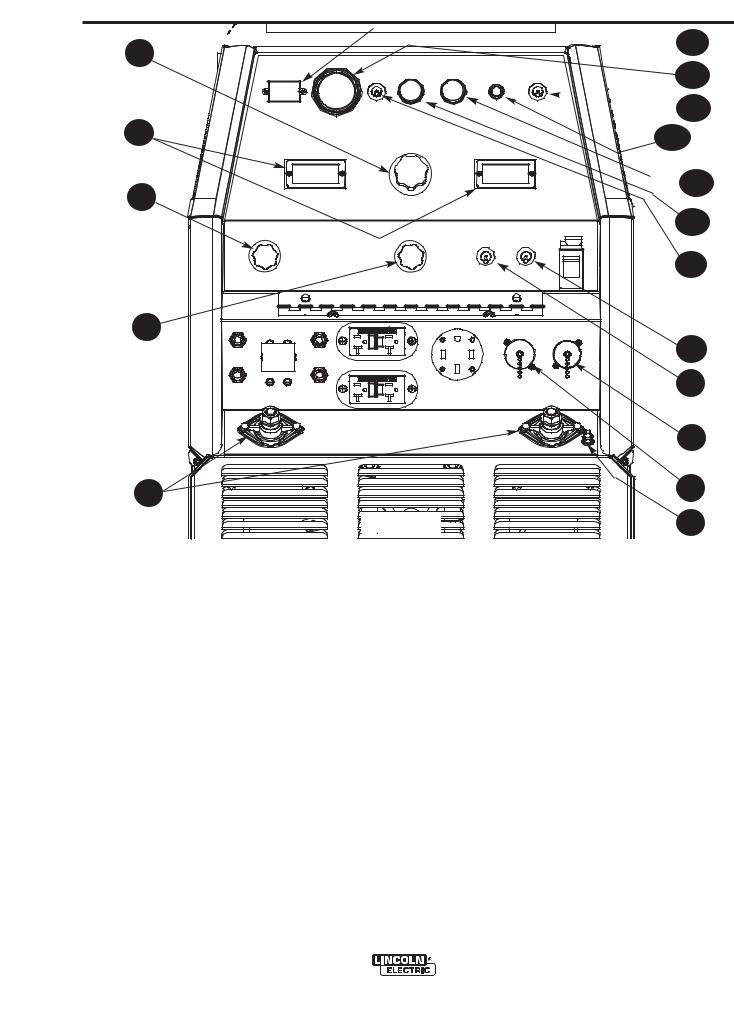
B-2 |
OPERATION |
B-2 |
1
2
3
4
5


 16
16
15  14
14
17
 13
13
12
11
10
9
8
7
FIGURE B.1 |
6 |
WELDING CONTROLS (Figure B.1)
1. OUTPUT CONTROL- The OUTPUT dial is used to preset the output voltage or current as displayed on the digital meters for the four welding modes. When in the CC-STICK, DOWNHILL PIPE or CV-WIRE modes and when a remote control is connected to the 6-Pin or 14-Pin Connector, the auto-sensing circuit automatically switches the OUTPUT CONTROL from control at the welder to the remote control.
In the CV-WIRE mode, when the wire feeder control cable is connected to the 14-Pin Connector, the auto-sensing circuit automatically makes OUTPUT CONTROL inactive and the wire feeder voltage control active.
When in the TOUCH START TIG mode and when a Amptrol is connected to the 6-Pin Connector, the OUTPUT dial is used to set the maximum current range of the CURRENT CONTROL of the Amptrol.
2. DIGITAL OUTPUT METERS-The digital meters allow the output voltage (CV-WIRE mode) or current (CC-STICK,DOWN HILL PIPE and TIG modes) to be set prior to welding using the OUTPUT control dial. During welding, the meter display the actual output voltage (VOLTS) and current (AMPS). A memory feature holds the display of both meters on for seven seconds after welding is stopped. This allows the operator to read the actual current and voltage just prior to when welding was ceased.
While the display is being held the left-most decimal point in each display will be flashing. The accuracy of the meters is +/- 3%.
3. WELD MODE SELECTOR SWITCH-
(Provides four selectable welding modes) CV-WIRE
DOWNHILL PIPE CC-STICK
TOUCH START TIG
RANGER® 305D
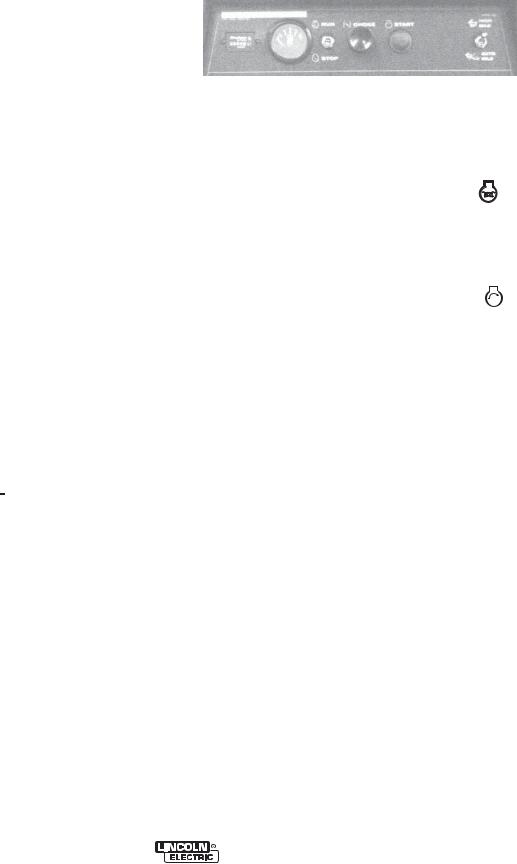
B-3 |
OPERATION |
B-3 |
4. ARC CONTROL- The ARC CONTROL dial is active in the CV-WIRE, CC-STICK and DOWNHILL PIPE modes, and has different functions in these modes. This control is not active in the TIG mode.
CC-STICK mode: In this mode, the ARC CONTROL dial sets the short circuit current (arc-force) during stick welding to adjust for a soft or crisp arc. Increasing the dial from –10 (soft) to +10 (crisp) increases the short circuit current and prevents sticking of the electrode to the plate while welding. This can also increase spatter. It is recommended that the ARC CONTROL be set to the minimum number without electrode sticking. Start with a setting at 0.
DOWNHILL PIPE mode: In this mode, the ARC CONTROL dial sets the short circuit current (arc-force) during stick welding to adjust for a soft or a more forceful digging arc (crisp). Increasing the number from –10 (soft) to +10 (crisp) increases the short circuit current which results in a more forceful digging arc. Typically a forceful digging arc is preferred for root and hot passes. A softer arc is preferred for fill and cap passes where weld puddle control and deposition ("stacking" of iron) are key to fast travel speeds. It is recommended that the ARC CONTROL be set initially at 0.
CV-WIRE mode: In this mode, turning the ARC CONTROL clock wise from –10 (soft) to +10 (crisp) changes the arc from soft and washed-in to crisp and narrow. It acts as an inductance/pinch control. The proper setting depends on the procedure and operator preference. Start with a setting of 0.
5. WELD OUTPUT TERMINALS WITH FLANGE NUT- Provides a connection point for the electrode and work cables.
6. GROUND STUD- Provides a connection point for connecting the machine case to earth ground.
Provides a connection point for connecting the machine case to earth ground.
7. 14-PIN CONNECTOR- For attaching wire feeder control cables to the RANGER® 305D. Includes contactor closure circuit, auto-sensing remote control circuit, and 120V and 42V power. The remote control circuit operates the same as the 6 Pin Amphenol.
8. 6-PIN CONNECTOR- For attaching optional remote control equipment. Includes auto-sensing remote control circuit.
9. WELD TERMINALS CONTROL SWITCH- In the WELD TERMINALS ON position, the output is electrically hot all the time. In the REMOTELY CONTROLLED position, the output is controlled by a wire feeder or amptrol device, and is electrically off until a remote switch is depressed.
10. WIRE FEEDER VOLTMETER SWITCH:
Matches the polarity of the wire feeder voltmeter to the polarity of the electrode.
ENGINE CONTROLS: (Figure B.2)
11. RUN/STOP SWITCH - RUN position energizes the engine prior to starting. STOP position stops the engine. The oil pressure interlock switch prevents battery drain if the switch is left in the RUN position and the engine is not operating.
12. GLOW PLUG PUSH BUTTON -
•When pushed activates the glow plugs. Glow plug should not be activated for more than 20 seconds continuously.
13. START PUSH BUTTON -
Energizes the starter motor to crank the engine.
14.IDLER SWITCH- Has two positions as follows:
1)In the HIGH position, the engine runs at the high idle speed controlled by the engine governor.
2)In the AUTO position, the idler operates as follows:
• When switched from HIGH to AUTO or after starting the engine, the engine will operate at full speed for approximately 12 seconds and then go to low idle speed.
• When the electrode touches the work or power is drawn for lights or tools (approximately 100 Watts minimum), the engine accelerates and operates at full speed.
• When welding ceases or the AC power load is turned off, a fixed time delay of approximately 12 seconds starts. If the welding or AC power load is not restarted before the end of the time delay, the idler reduces the engine speed to low idle speed.
• The engine will automatically return to high idle speed when there is welding load or AC power load reapplied.
RANGER® 305D
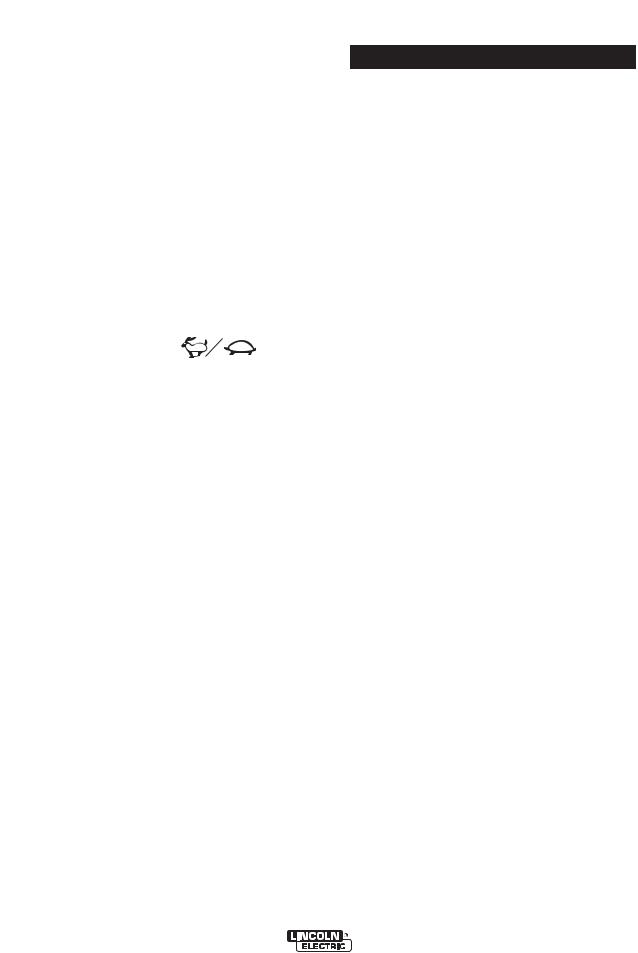
B-4 |
OPERATION |
B-4 |
15. ELECTRIC FUEL GAUGE- The electric fuel gauge gives accurate and reliable indication as to how much fuel is in the fuel tank.
16. ENGINE HOUR METER- Displays the total time that the engine has been running. This meter is useful for scheduling prescribed maintenance.
17. ENGINE PROTECTION LIGHT- A warning indicator light for Low Oil Pressure and/or Coolant Over Temperature. The light is off when the systems are functioning properly. The light turns on when the RUN-STOP switch is in the “ON” position prior to starting the engine. If the Engine Protection or Battery Charging Lights do “not” turn off shortly after starting the engine shut off the engine immediately and determine the cause.
STARTING THE ENGINE
NOTE: If the unit fails to start repeat step 4 through step 7 after waiting 30 seconds
 CAUTION
CAUTION
•Do not allow the starter motor to run continuously for more than 20 seconds.
•Do not push the START button while the engine is running because this can damage the ring gear and/or the starter motor.
•IF the Engine Protection or Battery Charging Lights do “not” turn off shortly after starting the engine shut off the engine immediately and deter
mine the cause.
--------------------------------------------------------------------------------
NOTE: When starting a RANGER® 305D for the first time, or after and extended period of time of not operating, it will take longer than normal because the fuel pump has to fill the fuel system.
1. |
Remove all plugs connected to the AC power |
STOPPING THE ENGINE |
|||||||||||
|
receptacles. |
|
|
|
|
|
|
Remove all welding and auxiliary power loads and |
|||||
|
|
|
|
|
|
||||||||
2. |
Set IDLER switch to AUTO. |
|
|
|
|
|
|
allow the engine to run at low idle speed for a few |
|||||
3. |
Set the RUN/STOP switch to RUN. |
|
|
|
|
minutes to cool the engine. |
|||||||
4. |
Press Glow Plug Button and hold 5 to 10 seconds. |
|
|
|
|
|
|||||||
5. |
Press and hold both the “Glow Plug” Button and |
STOP the engine by placing the RUN-STOP switch in |
|||||||||||
|
START button together until the engine starts or for |
the STOP position. |
|
|
|||||||||
|
up to 10 seconds. |
|
|
|
|
|
|
|
|
|
|||
6. |
Release the engine START button immediately |
NOTE: A fuel shut off valve is located on the fuel pre- |
|||||||||||
|
when the engine starts. |
|
|
|
|
filter. |
|
|
|||||
7. |
Release the glow plug button after the Engine |
WELDER OPERATION |
|||||||||||
|
Protection Light turns off or after an additional 5 |
||||||||||||
8. |
seconds maximum. |
|
|
|
|
DUTY CYCLE |
|
|
|||||
The engine will run at high idle speed for approxi- |
Duty Cycle is the percentage of time the load is being |
||||||||||||
|
mately 12 seconds and then drop to low idle speed. |
||||||||||||
|
applied in a 10 minute period. For example a 60% duty |
||||||||||||
|
Allow the engine to warm up at low idle for several |
||||||||||||
|
cycle, represents 6 minutes of load and 4 minutes of no |
||||||||||||
|
minutes before applying a load and/or switching to |
||||||||||||
|
load in a 10 minute period. |
||||||||||||
|
high idle. Allow a longer warm up time in cold |
||||||||||||
|
|
|
|
|
|
||||||||
|
weather. |
|
|
|
|
|
|
|
|
|
|||
|
|
|
|
|
|
|
|
TABLE B.1 |
|
|
|
||
|
|
|
|
|
|
|
|
||||||
|
|
|
|
|
|
|
|
|
|
|
|
|
|
|
|
TYPICAL RANGER® 305D FUEL CONSUMPTION |
|
||||||||||
|
|
|
|||||||||||
|
|
|
|
|
|
|
Kubota D722 |
|
|
|
Running time for |
|
|
|
|
|
|
|
|
|
Gal./Hr (Liters/Hr) |
|
12 gallons-hours |
|
|||
|
|
Low Idle - No Load |
|
|
|
|
|
|
|
|
|
||
|
|
2450 R.P.M. |
|
.29 (1.09) |
|
|
|
41.77 |
|
||||
|
|
High Idle - No Load |
|
|
|
|
|
|
|
|
|
||
|
|
3650 R.P.M. |
|
.54 (2.06) |
|
|
|
22.02 |
|
||||
|
|
DC Weld Output |
|
|
|
|
|
|
|
|
|
||
|
|
250 Amps @ 28 Volts |
|
1.03 (3.91) |
|
|
|
11.62 |
|
||||
|
|
DC Weld Output |
|
|
|
|
|
|
|
|
|
||
|
|
300 Amps @ 29 Volts |
|
1.18 (4.47) |
|
|
|
10.16 |
|
||||
|
|
|
|
|
|
|
|
|
|
|
|||
|
|
9,500 Watts |
|
1.16 (4.38) |
|
|
|
10.37 |
|
||||
|
|
|
|
|
|
|
|
|
|
|
|||
|
|
7,000 Watts |
|
.96 (3.63) |
|
|
|
12.50 |
|
||||
|
|
|
|
|
|
|
|
|
|
|
|||
|
|
3,000 Watts |
|
.70 (2.67) |
|
|
|
17.03 |
|
||||
|
|
|
|
|
|
|
|
|
|
|
|
|
|
RANGER® 305D

B-5 |
OPERATION |
B-5 |
The Ranger® 305D can be used with a broad range of DC stick electrodes. The MODE switch provides two stick welding settings as follows:
Constant Current (CC-STICK) Welding
The CC-STICK position of the MODE switch is designed for horizontal and vertical-up welding with all types of electrodes, especially low hydrogen. The output CONTROL dial adjusts the full output range for stick welding.
The ARC CONTROL dial sets the short circuit current (arc-force) during stick welding to adjust for a soft or crisp arc. Increasing the number from -10(soft) to +10(crisp) increases the short circuit current and prevents sticking of the electrode to the plate while welding. This can also increase spatter. It is recommended that the ARC CONTROL be set to the minimum number without electrode sticking. Start with the dial set at 0.
DOWNHILL PIPE Welding
This slope controlled setting is intended for "out-of-posi- tion" and "down hill" pipe welding where the operator would like to control the current level by changing the arc length. The output CONTROL dial adjusts the full output range for pipe welding. The ARC CONTROL dial sets the short circuit current (arc-force) during stick welding to adjust for a soft or more forceful digging arc (crisp). Increasing the number from -10(soft) to +10(crisp) increases the short circuit current which results in a more forceful digging arc.Typically a forceful digging arc is preferred for root and hot passes. A softer arc is preferred for fill and cap passes where weld puddle control and deposition (“stacking” of iron) are key to fast travel speeds. This can also increase spatter.
It is recommended that the ARC CONTROL be set to the minimum number without electrode sticking. Start with the dial set at 0.
TIG WELDING
The TOUCH START TIG setting of the MODE switch is for DC TIG (Tungsten Inert Gas) welding. To initiate a weld, the CONTROL dial is first set to the desired current and the tungsten is touched to the work. During the time the tungsten is touching the work there is very little voltage or current and, in general, no tungsten contamination. Then, the tungsten is gently lifted off the work in a rocking motion, which establishes the arc.
When in the TOUCH START TIG mode and when a Amptrol is connected to the 6-Pin connector the OUTPUT dial is used to set the maximum current range of the current control of the Amptrol.
The ARC CONTROL is not active in the TIG mode. To STOP a weld, simply pull the TIG torch away from the work. When the arc voltage reaches approximately 30 Volts the arc will go out and the machine will reset the current to the Touch Start level. To reinitiate the arc, retouch the tungsten to the work and lift. Alternatively, the weld can be stopped by releasing the Amptrol or arc start switch.
The RANGER® 305 D can be used in a wide variety of DC TIG welding applications. In general the ʻTouch Startʼ feature allows contamination free starting without the use of a Hi-frequency unit. If desired, the K930-2 TIG Module can be used with the RANGER® 305 D. The settings are for reference.
TYPICAL CURRENT RANGES (1) FOR TUNGSTEN ELECTRODES(2)
Tungsten Electrode |
DCEN (-) |
DCEP (+) |
Approximate Argon Gas Flow |
|
TIG TORCH |
|
||||
Diameter in. (mm) |
|
|
Flow Rate C.F.H. ( l |
/min.) |
|
Nozzle Size (4), (5) |
||||
|
|
|
|
|
|
|
|
|
|
|
|
|
1%, 2% Thoriated |
1%, 2% Thoriated |
Aluminum |
|
|
Stainless Steel |
|
|
|
|
|
Tungsten |
Tungsten |
|
|
|
|
|
|
|
|
|
|
|
|
|
|
|
|
|
|
.010 |
(.25) |
2-15 |
(3) |
3-8 |
(2-4) |
|
3-8 |
(2-4) |
#4, #5, #6 |
|
0.020 |
(.50) |
5-20 |
(3) |
5-10 |
(3-5) |
|
5-10 |
(3-5) |
|
|
0.040 |
(1.0) |
15-80 |
(3) |
5-10 |
(3-5) |
|
5-10 |
(3-5) |
|
|
1/16 |
(1.6) |
70-150 |
10-20 |
5-10 |
(3-5) |
|
9-13 |
(4-6) |
#5, #6 |
|
3/32 |
(2.4) |
150-250 |
15-30 |
13-17 |
(6-8) |
|
11-15 |
(5-7) |
#6, #7, #8 |
|
1/8 |
(3.2) |
250-400 |
25-40 |
15-23 |
(7-11) |
|
11-15 |
(5-7) |
|
|
5/32 |
(4.0) |
400-500 |
40-55 |
21-25 |
(10-12) |
|
13-17 |
(6-8) |
#8, #10 |
|
3/16 |
(4.8) |
500-750 |
55-80 |
23-27 |
(11-13) |
|
18-22 |
(8-10) |
|
|
1/4 |
(6.4) |
750-1000 |
80-125 |
28-32 |
(13-15) |
|
23-27 |
(11-13) |
|
|
|
|
|
|
|
|
|
|
|
|
|
|
|
|
|
|
|
|
|
|
|
|
(1)When used with argon gas. The current ranges shown must be reduced when using argon/helium or pure helium shielding gases.
(2)Tungsten electrodes are classified as follows by the American Welding Society (AWS):
Pure |
EWP |
1% Thoriated |
EWTh-1 |
2% Thoriated |
EWTh-2 |
Though not yet recognized by the AWS, Ceriated Tungsten is now widely accepted as a substitute for 2% Thoriated Tungsten in AC and DC applications.
(3)DCEP is not commonly used in these sizes.
(4)TIG torch nozzle "sizes" are in multiples of 1/16ths of an inch:
# 4 = 1/4 in. |
(6 mm) |
|
# 5 |
= 5/16 in. |
(8 mm) |
# 6 |
= 3/8 in. |
(10 mm) |
# 7 |
= 7/16 in. |
(11 mm) |
# 8 |
= _ in. |
(12.5 mm) |
#10 = 5/8 in. |
(16 mm) |
|
(5)TIG torch nozzles are typically made from alumina ceramic. Special applications may require lava nozzles, which are less prone to breakage, but cannot withstand high temperatures and high duty cycles.
RANGER® 305D

B-6 |
OPERATION |
B-6 |
RANGER® 305 D settings when using the K930-2 TIG Module with an Amptrol or Arc Start Switch:
•Set the MODE Switch to the TOUCH START TIG setting.
•Set the "IDLER" Switch to the "AUTO" position.
•Set the "WELDING TERMINALS" switch to the "REMOTELY CONTROLLED" position. This will keep the "Solid State" contactor open and provide a "cold" electrode until the Amptrol or Arc Start Switch is pressed.
When using the TIG Module, the OUTPUT control on the RANGER® 305 D is used to set the maximum range of the CURRENT CONTROL on the TIG Module or an Amptrol if connected to the TIG Module.
WIRE WELDING-CV
Connect a wire feeder to the RANGER® 305 D according to the instructions in INSTALLATION INSTRUCTIONS Section.
The RANGER® 305 D in the CV-WIRE mode, permits it to be used with a broad range of flux cored wire (Innershield and Outershield) electrodes and solid wires for MIG welding (gas metal arc welding). Welding can be finely tuned using the ARC CONTROL. Turning the ARC CONTROL clockwise from –10 (soft) to +10 (crisp) changes the arc from soft and washed-in to crisp and narrow. It acts as an inductance/pinch control. The proper setting depends on the procedure and operator preference. Start with the dial set at 0.
Listed below are some wires suitable for use on this machine:
•Innershield - NR-311, NS-3M, NR-207, NR-203 Ni 1%, NR-212.
•Outershield - 0S-70, 0S-71M, 0S-71 ELITE.
•Solid wires for MIG welding - .035 (0.9 mm), and
.045 (1.1 mm), Super Arc L-50 and L-56, .035 (0.9 mm) and
.045 (1.1 mm) Blue Max MIG 308 LS.
Contact your local authorized Lincoln Electric Distributor or the Lincoln Electric Company for specific wires used on certain applications with this machine.
ARC GOUGING
The RANGER® 305D can be used for limited arc gouging. For optimal performance, set the MODE switch to CC-STICK and the ARC CONTROL to +10.
Set the OUTPUT CONTROL knob to adjust output current to the desired level for the gouging electrode being used according to the ratings in the following Table.
Carbon Diameter |
Current Range (DC, electrode |
|
positive) |
1/8" |
60-90 Amps |
5/32" |
90-150 Amps |
3/16" |
200-250 Amps |
|
|
RANGER® 305D
